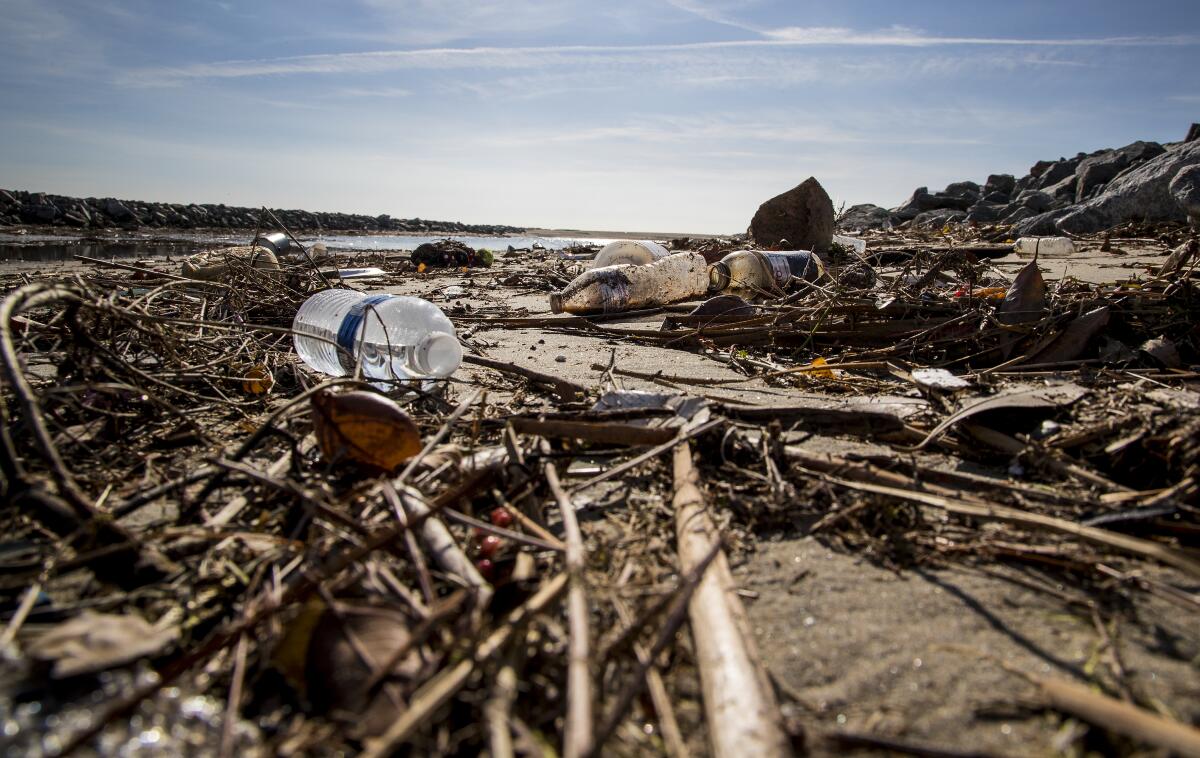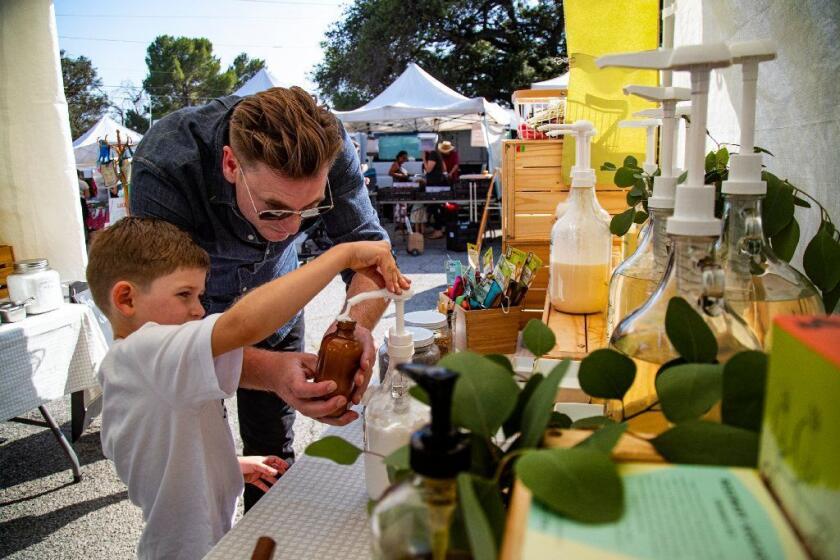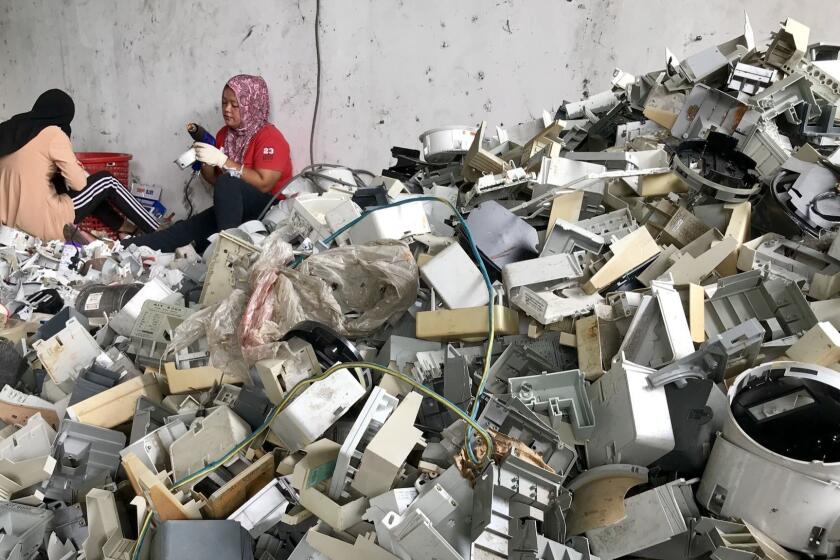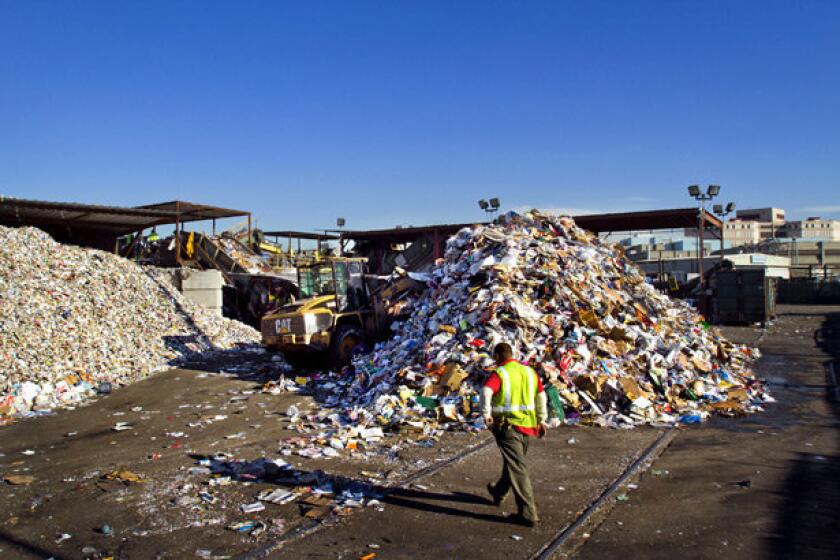It’s crunch time for California’s plan to phase out single-use plastics by 2030

- Share via
SACRAMENTO — With pressure mounting to address the state’s recycling crisis, California lawmakers are close to deciding on three far-reaching pieces of plastics legislation, including one that would phase out non-recyclable single-use packaging containers by 2030.
All three bills are potentially close to landing on the desk of Gov. Gavin Newsom, but they face varying levels of opposition from plastics makers and consumer goods companies, some of which have mounted 11th-hour campaigns to kill or weaken the proposals.
California has been a trailblazer in banning single-use plastics bags and turning plastic straws into fast-food pariahs, but a sunset for single-use containers would thrust the state into new territory. So would a bill by Assemblyman Phil Ting (D-San Francisco), which would require beverage containers to contain no less than 75% recycled plastic content by 2035.
“We’re taking a hard look at ourselves,” said Ting, the author of AB 792. “We have to take more drastic action. We need to not be a disposable society, but a recyclable society.”
Recycling markets in California and nationwide have been roiled by China’s decision not to accept certain containers that consumers tossed into their blue bins for years. The collapse of the market for plastics and other recovered items has forced many recycling centers to either pay to get rid of their recyclables or dump them in landfills, a trend that has contributed to the closure of scores of redemption centers statewide.
What can be recycled in Los Angeles? Some plastic, all glass, most paper, but not your garden hose.
With market conditions unlikely to change, many state lawmakers want state policy to refocus on the raw waste that results from companies marketing billions of single-use containers, and consumers purchasing them.
Ting’s bill to require more recycled content in beverage bottles is one approach. The phase-out of non-recyclable single-use packaging — contained in AB 1080 and SB 54 — aims to limit the production of virgin plastics by requiring containers to be made from materials that can be recycled or composted.
Authors of the bills have continued to hold discussions with plastics manufacturers in an effort to develop legislation that manufacturers can implement.
“We have been working really hard, and engaging in robust discussions all summer long, and really trying to do everything we can to incorporate their concerns while making sure we stay true to the core goal of the bill,” said Sen. Ben Allen (D-Santa Monica), who introduced SB 54.
In a key shift, the California Grocers Assn. came out in support of AB 1080 and SB 54 Wednesday. According to Ronald Fong, the association’s chief executive, his members were concerned about obtaining types of food-safe plastic that would meet the bill’s proposed standards and the potential lack of infrastructure to recycle these plastics.
After lengthy negotiation, lawmakers and association representatives agreed on modifications that will allow some flexibility for food containers and help jump-start the needed recycling infrastructure.
Some industry lobbyists have suggested there’s a deal to be cut in the waning days of the legislative session, but have also raised concerns about the ability to implement legislation in a collapsed recycling market while keeping products available and affordable for consumers.
“I think we’re on the same page with what these bills are trying to accomplish,” said Tim Shestek, senior director of state affairs for the American Chemistry Council. “I think where there is an issue is the mechanics — how are we going to get there?”
Jasper and Vjera Watts, along with their two young children, are trying to live a plastic-free life. It isn’t easy.
A remaining point of contention, according to Shestek, relates to giving CalRecycle, the agency tasked with compliance oversight, authority over companies while there is not an existing regulatory framework. Shestek said companies may request that CalRecycle implement a study of existing infrastructure prior to enacting legislation, which could significantly delay the timeline for implementing changes.
Others have mounted campaigns against the proposals. Novolex — a South Carolina company that spent millions of dollars on a unsuccessful effort to kill California’s plastic bag ban — is financing a social media campaign to spread concerns about the legislation.
With the innocuous name of “Californians for the Environment and Recycling,” the campaign claims that SB 54 and AB 1080 “will unintentionally impact the availability, affordability and quality of many products that families rely on for food, health, and well-being.”
According to research cited in AB 1080, global plastic production has reached 335 million tons a year and is projected to more than triple by 2050. Meanwhile, within California, according to the bill, statewide recycling levels haven’t topped 44% and the state hasn’t implemented meaningful requirements for businesses to contribute to the reduction.
Plastics companies are also seeking to reduce some of the recycled content targets proposed. Already, negotiations on AB 792 whittled its original 100% recycled content target down to 75% as a result of complaints from plastic manufacturers.
“Manufacturers said it was near impossible to have 100% [recycled] content,” said Ting. “Because for plastic bottles [of certain colors] there is no way to make them 100% recyclable, so we moved down to 75%.”
The journey of scrap from California to a junkyard 8,500 miles away tells the story of the reshaping of the global garbage and recycling system.
Current amendments to AB 792 extend the timeline for compliance as far out as 2035, and also create categories of beverage containers that are exempt.
Despite efforts on the part of lawmakers to address concerns, other stakeholders remain opposed to legislation that may be more costly and difficult to implement.
The Grocery Manufacturers Assn., a trade group representing the packaged goods industry that is separate from the California Grocers Assn., issued an Aug. 28 news release calling on California legislators to pass a “workable” recycling policy.
Bearing the headline, “We can either work together to fix the recycling system, or the state can celebrate a hollow victory,” the release cites the numerous jobs created by packaging industries, and calls for a two-step legislation process that would in effect delay the legislation until public comment is completed over the next year.
Environmental advocates have denounced any delay to new mandates, arguing that the problems with recycling and plastics pollution must be addressed immediately.
“If we don’t act soon this problem is going to get worse,” said Geoff Shester, California campaign director and senior scientist at Oceana. “We’re already in a situation where if we stopped all the plastic production today, we still have decades and decades of cleanup.”
Plastic packaging is the easy choice for restaurants. A new law would require a shift to products better for the environment.
Sen. Allen is optimistic the bills will pass, in part because of the toll the waste crisis is taking on local governments and taxpayers.
The League of California Cities has backed both bills. According to Derek Dolfie, the group’s legislative representative, cities that once generated income from recycling are now paying high prices to dispose of waste. Many cities have reported spending $100,000 or more annually, and according to AB 1080 the yearly statewide the cost for waste disposal is estimated to be in the millions.
“These bills deal with source reduction on the front end so cities don’t have deal with all the waste on the back end,” said Dolfie.
All three bills have passed one of the two legislative chambers, and await votes before the Sept. 13 close of the legislative year. If passed, they will go to the governor, who would have until Oct. 13 to take action on them.
“We do have a waste management crisis here in California. We need to address it; we need to do it for the sake of our cities and our communities,” said Allen. “But at the same time we also need to show the rest of the world that they can and ought to be doing something about this.”









